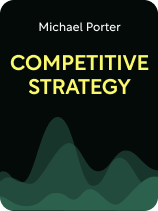

This article is an excerpt from the Shortform book guide to "Competitive Strategy" by Michael Porter. Shortform has the world's best summaries and analyses of books you should be reading.
Like this article? Sign up for a free trial here.
What is Competitive Strategy by Michael Porter about? Do you want a competitive edge in the business world?
In Competitive Strategy, Michael Porter demonstrates how to get your business in the lead. Doing so requires a certain level of competitiveness that puts your business first.
Read below for a brief overview of Competitive Strategy.
Competitive Strategy by Michael Porter
In Competitive Strategy, Michael Porter—renowned economist, best-selling author, and Harvard Business School professor—presents a comprehensive framework for businesses seeking to achieve a competitive advantage. Originally published in 1980, this groundbreaking book revolutionized the field of strategic management and remains an invaluable resource for business leaders operating in complex and competitive environments.
This overview explores Porter’s insights and practical advice in three parts:
- Part 1 covers five factors that influence a market’s competitiveness and profit potential.
- Part 2 explores four research areas that are vital for understanding and anticipating your competitors’ strategies.
- Part 3 presents three strategies for managing the five factors and outperforming competitors.
Part 1: Understand the Factors That Shape Your Market
According to Porter, before you can develop an effective competitive strategy for your business, you first need to understand five interdependent factors that influence the competitiveness and profit potential of the market you’re operating in:
- Supplier influence
- Buyer influence
- New competitors
- Alternative offers
- Rivalry competitiveness
Let’s explore in detail how each of these factors shapes a market.
Factor #1: Supplier Influence
The first factor that shapes a market is how much influence suppliers have. Porter explains that suppliers with substantial influence can dictate pricing, product quality, and availability, potentially limiting competition and profitability. For example, in the diamond industry, a few large diamond mining companies exert significant influence over jewelry manufacturers and vendors by dictating prices, setting quality standards, and restricting sales.
Factor #2: Buyer Influence
The second factor that shapes a market is how much influence buyers have. According to Porter, influential buyers can impact what businesses offer and their pricing strategies, as well as overall market demand for products and services. For example, in the smartphone market, buyers exert significant influence due to their ability to readily switch brands to meet their specific demands, whether it be for certain features or more affordable prices.
Factor #3: New Competitors
The third factor that shapes a market is the ease of entry for new competitors. Porter explains that markets pose varying degrees of challenges that influence new entrants’ ability to compete against established businesses. These challenges impact both the level of competition and the potential for market disruption. For example, in the e-commerce market, storefront technologies and global shipping infrastructures make it easier for new companies to enter the market. However, markets saturated by competitors pose challenges such as building brand recognition and establishing trust.
He states that new competitors find it easier to enter a market under a number of conditions, including:
- Low entry costs. Reduced capital requirements and financial barriers make it easier for new entrants to access the market without significant upfront investments.
- Absence of significant barriers. When there are no substantial legal, regulatory, or technological obstacles in place, new competitors can enter the market more easily.
- Favorable government policies. Government initiatives and policies that promote competition, reduce regulations, or offer incentives to new entrants facilitate easier market entry.
- Accessible distribution channels. Availability of open and accessible distribution channels, such as online platforms or partnerships with established distributors, simplifies the entry process for new competitors.
- Limited competitive advantage. If established businesses lack significant cost or quality advantages that are hard to replicate, it becomes easier for new entrants to compete on an equal footing.
Factor #4: Alternative Offers
The fourth factor that shapes a market is the potential for buyers to purchase alternative offers from other markets—the availability of other cheaper or better-quality offers that perform the same function as a product or service. For example, in the automobile market, the potential for alternative offers exists when customers find it more convenient or cost-effective to switch from owning a car to using substitute modes of transportation, such as public transport or ride-sharing services.
According to Porter, the likelihood of customers switching from an offer in one market to a substitute offer from another market increases competition, reduces market demand, and forces businesses to set lower prices.
Factor #5: Rivalry Competitiveness
The fifth factor that shapes a market is the extent of rivalry competitiveness. Porter explains that the degree of competition among existing rivals dictates the amount businesses must invest to acquire and retain customers. For example, in the fast-food industry, intense competition drives rivals to continuously invest in new product development, promotions, and expensive mass-marketing campaigns to outshine one another and capture market share.
Part 2: Analyze Your Competitors’ Strategies
In addition to understanding the factors that shape your market, analyze your competitors’ strategies. According to Porter, researching your competitors will benefit you in two ways. First, it will enable you to create effective countermoves to their strategies. Second, it will help you anticipate their responses to your strategic initiatives. He suggests four areas of research:
- Competitors’ objectives
- Competitors’ self-perceptions and decisions
- Competitors’ current approaches
- Competitors’ strengths and weaknesses
Let’s explore the insights you’ll gain by researching each of these areas.
Research Area #1: Competitors’ Objectives
Porter suggests that researching your competitors’ objectives helps you ascertain whether they are satisfied with their current performance and market position, which enables you to accurately predict their reactions to shifting market conditions.
- Example: Your competitor’s goal is to acquire a 30% market share. Since they only hold 10%, you can assume that they’re dissatisfied with their performance and will react aggressively to any threats that hinder their growth plans.
Additionally, this line of research helps you identify whether you and your competitors share common objectives or if your objectives differ.
Common objectives: Areas where your goals align with those of your competitors indicate the potential for intense competition in the future. For instance, if multiple competitors plan to expand into a specific market segment simultaneously, they might inadvertently increase competition by targeting the same customer base or devising similar marketing campaigns.
Differing objectives: Areas where your goals diverge from those of your competitors indicate opportunities to capitalize on differentiation. For example, if your competitors aim to offer the cheapest products while you strive to provide the most innovative ones, you can position yourself as a premium brand catering to customers seeking superior products.
Research Area #2: Competitors’ Self-Perceptions and Decisions
Porter explains that researching how your competitors perceive themselves reveals insights into their assumptions and decision-making patterns.
- Example: A competitor that perceives itself as affordable might assume that price is the primary factor influencing purchasing decisions. This assumption influences all its strategic decisions, such as choosing to prioritize cost reduction over innovation.
According to Porter, the insights you gain on your competitors’ decision-making process can reveal specific market needs that they’re overlooking—which, in turn, enables you to position your business effectively in relation to theirs.
Example: Because your competitor prioritizes cost-cutting over innovation, it overlooks customers who value superior quality products. This suggests an opportunity to capitalize on a market gap and avoid direct competition: Position your business as a premium brand that caters to customers seeking high-end products.
Research Area #3: Competitors’ Current Approaches
According to Porter, researching your competitors’ current approaches reveals how they organize their resources and operational procedures to meet their objectives. This information enables you to monitor and evaluate the effectiveness of their strategies and anticipate potential strategic shifts.
Example: Your competitor prioritizes exceptional customer service, allocating significant resources to ensure customer satisfaction and retention. By monitoring its high customer satisfaction and retention rates, you evaluate the effectiveness of its strategy and predict that it’ll continue to focus on customer-centric approaches to maintain a competitive edge.
Research Area #4: Competitors’ Strengths and Weaknesses
Porter suggests that researching your competitors’ strengths and weaknesses helps you identify two key areas: areas where they have a competitive advantage, potentially posing formidable challenges to your business; and areas where they are vulnerable and that you can take advantage of to gain a competitive edge.
Example: Your competitor has a strong distribution network and loyal customer base, so it will be difficult for you to attract its existing customers. However, it does have a limited online presence, so you can leverage digital marketing strategies to reach the online customers that it’s unable to acquire.
Part 3: Determine Your Competitive Strategy
Once you’ve understood the factors that impact your market and have completed your competitor analysis, determine how you’ll manage the five factors and outperform your competitors.
Porter suggests that you align your operational procedures with one of three strategies to gain a competitive advantage in your market:
- Set lower prices.
- Offer something unique.
- Target niche markets.
Let’s explore how to implement each of these strategies.
Strategy #1: Set Lower Prices
The first strategy for gaining a competitive advantage is to set the lowest market prices for your products and services. Porter explains that this strategy attracts price-sensitive customers, safeguards against more expensive substitute offers, and makes it difficult for both existing and new competitors to expand their market share.
To implement this strategy, Porter suggests that you identify areas to reduce operational costs without compromising quality or customer satisfaction. Achieve this by:
- Streamlining operational procedures: Simplify and optimize internal processes to eliminate inefficiencies, reduce waste, and improve productivity.
- Negotiating favorable supplier contracts: Secure more advantageous terms, such as lower prices, extended payment terms, or volume discounts.
- Capitalizing on economies of scale: Maximize cost advantages through increased production or expansion, benefiting from bulk purchasing, efficient resource utilization, and spreading fixed costs over larger output volumes.
Strategy #2: Offer Something Unique
The second strategy for gaining a competitive advantage is to offer something unique to the market. According to Porter, the main advantage of this strategy is that it acts as a defense against buyers looking for the cheapest deal. This is because, without comparable alternatives, buyers have no choice but to purchase from you—even if your prices are high. Additionally, offering something distinctive captures customer attention and cultivates loyalty among those who value uniqueness and are willing to pay premium prices for it.
To implement this strategy, Porter recommends that you invest in innovation and conduct market research to identify opportunities for setting your business apart from the competition. This can involve differentiating your branding, your packaging, your product or service features, or the way you interact with customers.
Strategy #3: Target Niche Markets
The third strategy for gaining a competitive advantage is to target niche markets, focusing on specific customer groups with unique requirements. Porter explains that narrowing your focus deepens your understanding of your customers, which enables you to serve them more effectively than competitors targeting the entire market. As a result, it’s easier for you to establish a strong position within your niche and cultivate a loyal customer base.
To implement this strategy, Porter suggests that you identify underserved customer groups, align your offerings with their needs, and develop targeted marketing campaigns to foster strong relationships within the niche community.

———End of Preview———
Like what you just read? Read the rest of the world's best book summary and analysis of Michael Porter's "Competitive Strategy" at Shortform.
Here's what you'll find in our full Competitive Strategy summary:
- The groundbreaking book revolutionized the field of strategic management
- A guide for businesses seeking to achieve a competitive advantage
- How to anticipate and understand your competitors' strategies






